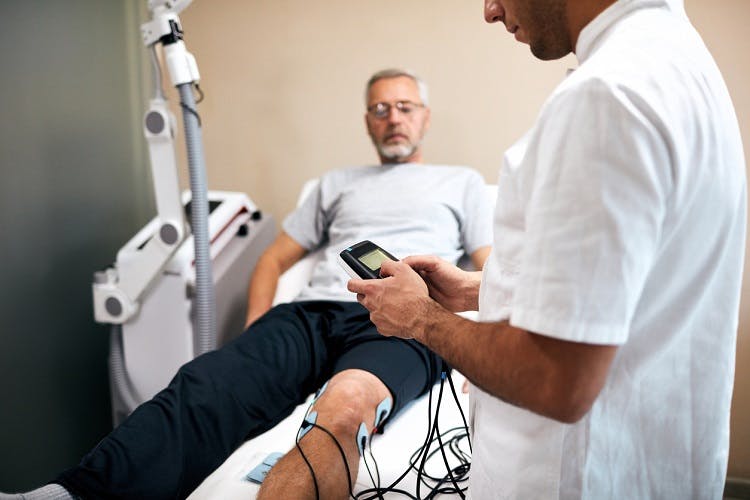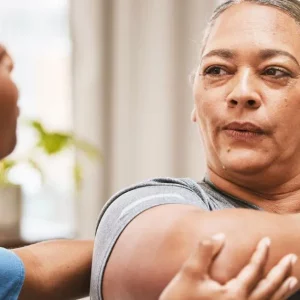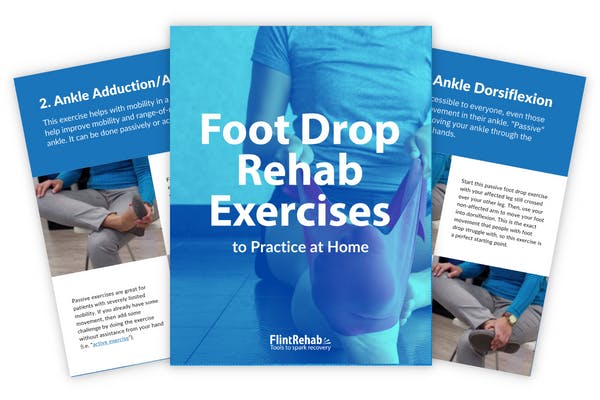Foot drop is characterized by the inability to lift the front of the foot toward the shin, known as dorsiflexion. Fortunately, there are various types of treatments that can help manage and improve foot drop such as nerve stimulation.
Foot drop treatments like nerve stimulation help encourage neuroplasticity, the brain’s natural ability to rewire itself. When foot drop is caused by neurological injury such as a stroke, neuroplasticity is the key to recovery.
This article will discuss how nerve stimulation can be used to treat foot drop, lower the risk of further injury, and help maximize recovery.
What Causes Foot Drop?
The brain is responsible for sending nerve signals to the muscles telling them when to contract and relax. When the areas of the brain responsible for controlling movement, such as the motor cortex, are affected by a neurological injury like TBI or stroke, the muscles are unable to receive appropriate signals. As a result, movements like dorsiflexion (lifting the foot toward the shin) can become impaired, resulting in foot drop.
Another common cause of foot drop is injury to the peroneal nerve. The peroneal nerve (also called the common fibular nerve) is a branch of the sciatic nerve that wraps from the back of the knee to the outside of the lower leg. Because the nerve is very close to the surface, it can become easily damaged, especially after an injury.
The peroneal nerve is particularly important because it controls the muscles that lift your foot, such as the tibialis anterior. Damage to this nerve can impair dorsiflexion and result in foot drop, making it difficult to walk and safely navigate around. Damage to the peroneal nerve can occur from sports injuries, fracture, or hip or knee replacement surgery.
How Can Nerve Stimulation Help Treat Foot Drop?
Although managing foot drop can be challenging, there are many treatments available. Treatment depends on the cause and severity of your foot drop. For example, when foot drop is caused by a neurological injury like stroke or damage to the peroneal nerve, the best treatment approach is rewiring the brain and nerves through neuroplasticity.
Neuroplasticity helps strengthen the neural connections needed to execute a movement, like dorsiflexion. This is best achieved through high repetition of foot drop exercises. The more a movement is practiced, the more the brain will recognize that movement and strengthen its neural connections.
While rehabilitation exercises are essential to treat the root cause of foot drop, this can be particularly challenging for individuals with limited mobility. Fortunately, there are other treatment methods to promote neuroplasticity, such as nerve stimulation, also called neuromuscular electrical stimulation.
Nerve stimulation for foot drop involves placing electrodes on the lower leg muscles and sending electrical impulses through the skin. These electrical impulses help create a contraction in the affected muscles, like the tibialis anterior. Activating these muscles encourages dorsiflexion and stimulates the brain, strengthening the muscles and improving neural pathways. When used consistently, this can help reduce foot drop.
Functional Electrical Stimulation for Foot Drop Recovery
Nerve stimulation provides many benefits and studies have shown that it is most effective when combined with rehabilitation exercises. One method of nerve stimulation, called functional electrical stimulation, can be used during activities such as walking or climbing stairs to help promote dorsiflexion and avoid dragging the toe. Ask your physical therapist to train you to use a nerve stimulation machine to know where to place the electrodes and how to safely operate the equipment.
As your mobility improves, it is important to participate in physical therapy and practice foot drop exercises frequently. Your therapist may even show you how to simultaneously perform nerve stimulation during your foot drop exercises.
While nerve stimulation is usually a non-invasive treatment, in some cases electrodes can be surgically implanted in an individual’s legs. If you are interested in this treatment to help you improve foot drop, it is important to consult with your doctor to determine if nerve stimulation is a safe and appropriate treatment for you. Your doctor and therapist can also provide you with alternative treatment options that are appropriate for your condition.
Alternative Treatments to Nerve Stimulation for Foot Drop
While nerve stimulation is one of the most effective treatments for foot drop, it may not be appropriate for everyone. If this is the case, there are other methods that can help you manage the symptoms of foot drop.
For example, many therapists recommend using an ankle foot orthosis, or an AFO brace. AFOs provide support to the foot and ankle to assist with dorsiflexion and help prevent the toes from dragging on the floor. This helps lower the risk of tripping, falling, and further injury.
However, AFOs are compensatory strategies, meaning they do not treat the root cause of foot drop. It is important to work closely with your therapist because they can provide you with a proper rehabilitation plan to support your recovery, even if you use an AFO brace.
Additionally, for more severe cases of foot drop, surgical interventions may be necessary. This can include nerve transfers or decompressive surgery. Be sure to talk to your doctor to explore all your options before considering surgery.
Understanding Nerve Stimulation for Foot Drop
Foot drop can make it difficult to walk, perform daily activities, and navigate safely on your own. While there may be various causes of foot drop, some of the most common include peroneal nerve damage or the disruption in communication between the brain and affected muscles due to stroke or TBI.
Fortunately, foot drop can be improved through a combination of treatments. For example, nerve stimulation is a great way to encourage muscle contraction, especially for individuals with limited to no mobility, and can even be used during functional activities such as walking. Nerve stimulation is most effective when combined with foot drop exercises.
We hope this article helped you understand how nerve stimulation can help manage foot drop and motivate you to practice rehab exercises.
















